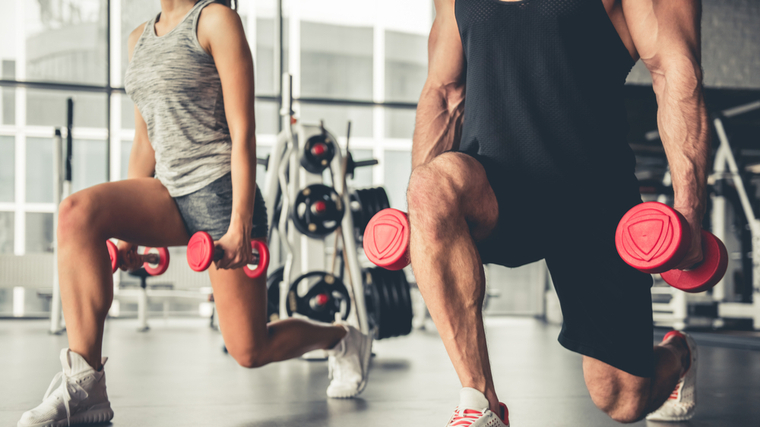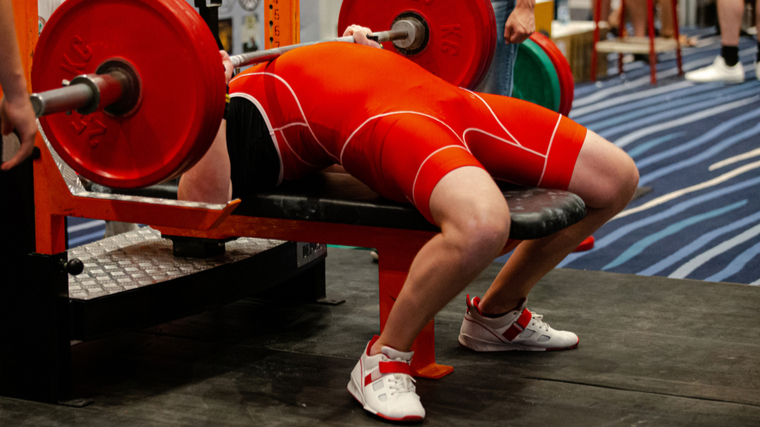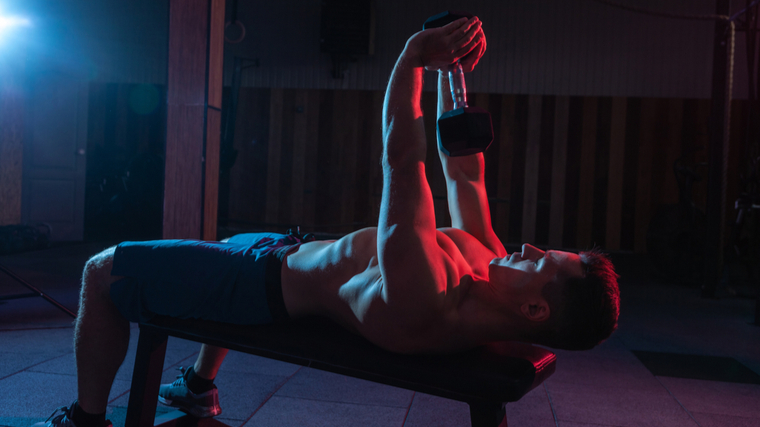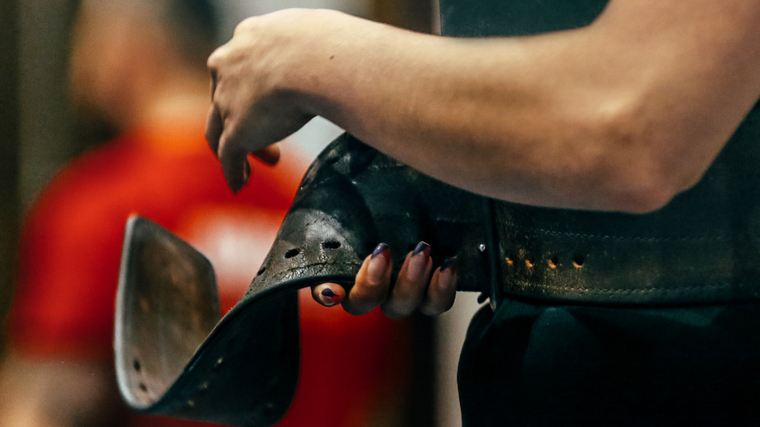The Best Exercise Tips For Your Body Type (original) (raw)
Some people are built to train. If you’ve ever known someone who benched two plates in their first few months of lifting weights, it may have left you scratching your head (or seething with jealousy). Do they know something you don’t, or are they just blessed by the gods of strength?
Like most things in the fitness world, the answer lies somewhere in the middle. Picking up a barbell for the first time sets you on a path, but your journey never looks quite like anyone else’s. Believe it or not, your body type can strongly influence how you train — and the results that follow.

Credit: VGstockstudio / Shutterstock
Your time in the gym is valuable. You should know where to direct the most effort and what to leave by the wayside. To that end, this guide will help shed some light on your own strengths and weaknesses, and how to make the most of what you’ve got.
Defining Biomechanics
Your body is, literally, a machine. It’s fair to think of human movement as a series of lever and pulley systems that work together to make physical activity possible. That said, the human skeleton is anything but factory-made.
From the length, shape, and density of your bones to where your tendons insert and what leverages you have to work with as a result, your physical framework is completely individual. An understanding of your own biomechanics is essential for knowing what exercises are right for you and how to use them to make gains.
While there are many ways to define or categorize different body types, when it comes to lifting weights, the length of your limbs relative to that of your torso is one of the biggest factors that affects how you perform with a barbell in your hands.
Technique Tips for Long Limbs
If you were cursed — or blessed, depending on your point of view and activity of choice — with long limbs, you may find yourself struggling with certain lifts that come easy to your training partner. Conversely, trainees with longer arms or legs tend to excel in areas their stockier counterparts may fall short.
It’s worth pointing out that you don’t necessarily need to be tall to have long limbs. It’s certainly possible to bear a large wingspan without pushing six feet. If that’s the case, some of these tips should still be relevant for you.
Squats
No matter how you slice it, long legs are the bane of a squatter’s existence. Since your femur is the primary moving lever in any type of squat, an extra-long thigh bone means extra-long reps. Fortunately, there are some easy tweaks you can try.
Turn Your Feet Out
By pointing your toes outward to a comfortable degree, you can artificially “shorten” the length of your femur. When you squat, your knee translates forward and your hips move down and back as needed. By turning your stance out, your knee won’t drive as far forward as it tracks out to match your feet. This should help you feel more upright and sink into a deeper squat if your hip mobility allows.
Use a Heel Lift
Forward knee travel is essential to a deep and balanced squat, especially for those with long legs. The less flexible your ankles are, the more mobility you’ll need in your hips to get below parallel (and vice-versa).
If you place a pair of change plates under your heels or wear weightlifting shoes, you can adjust your center of gravity in a way that makes it more comfortable to push your knees forward, making more room for your legs at the bottom.
Swap to Anterior Loads
The longer your thigh is, the further behind your midline your hips will be when you squat. Having too much of your own weight behind you can interfere with your balance while squatting — it’s common for tall athletes to feel like they might fall backward at any moment.
You can accommodate for your mechanics by swapping to a squat variation that places the resistance in front of you. Front squats, Zercher squats, or goblet squats all work wonders by providing you a counterweight to work with, helping you stay centered while you move.
Widen Your Stance
The width of your squat stance dictates how much work you’re willing to put your hips through. If you’ve got long legs, you may find that squatting with a narrow stance, pelvis directly on top of your feet, doesn’t give you very much physical room to move around past a certain point.
Instead, widening your stance such that your hips fall between your feet can help you sit lower into a more comfortable squat. It’s also a good way to accommodate for limited ankle mobility. However, providing your hips with more room to move will challenge your flexibility to a greater degree.
Cut Your Depth
When it comes to muscle recruitment and strength gains, more range of motion is usually better. But if you find yourself incapable of sinking into a deep squat no matter what you do, you may have to cut your losses.
Squatting to a box or using pins to limit depth allows you to perform the exercise without constantly worrying about falling over or using poor form. As an aside, it’s easy for a set of squats to turn into a cardio workout if you’ve got very long legs.
Squats should be hard, but if your goal is to gain muscle or strength, your lungs shouldn’t be the limiting factor. Trimming your depth in one way or another may help you focus on the reason you’re squatting in the first place.
Presses
If you’ve been able to reach the top shelf in the kitchen your whole life, you’re likely paying the price in the weight room. Long arms are incredibly useful for day-to-day activity, but just like long legs can inhibit squat performance, a large reach may not make you the best bench presser in the house.
Retract the Scapula
Performing chest presses with longer arms means a larger range of motion, which is great for making gains. It also means more potential areas of instability. Since your elbow and wrist joints, as well as the weight itself, are comparatively further from your shoulder, errant movement or sloppy form may be particularly detrimental if you’ve got long arms.
To ensure you’re pressing safely, make sure your shoulder blades are properly retracted and compressed while you’re performing any type of chest press, particularly with a barbell.
Find the Right Angle
Pressing movements can feel unnatural if you’ve got longer arms. Although you’re likely to acclimate to any technique over time with enough practice, don’t be afraid to make small adjustments to your setup. A flat bench press may cause pain or pinching in your shoulders, but working from a slight incline (or decline) alleviates it entirely.
Unless you’re aspiring to be a powerlifter, there’s no reason you can’t modify your press of choice to better suit your own structure.
Utilize Leg Drive
Chest and overhead presses target your pecs and delts, but that doesn’t mean you can’t utilize other muscles along the way. If you’re training for strength, the overhead press is a fantastic all-around movement, but can be prohibitively difficult for those with long arms.

Credit: sportpoint / Shutterstock
Incorporating some leg drive and performing push presses instead allows you to work on your overhead strength and move big weights without being limited by an extreme range of motion. A similar idea also applies to the bench press — tenured powerlifters know the benefit of adding leg drive to your bench for max strength.
Widen Your Grip
If your shoulders are healthy and stable, widening your grip on barbell presses is a quick and dirty way to cut down on your range of motion. A widened grip on the bench press will allow you to touch your chest with the bar without your upper arm drifting too far below your torso, which may be an uncomfortable or dangerous position depending on your anatomy and experience.
Pulls
Long arms are an undeniable advantage for pulling. That said, if you’ve got longer legs relative to your torso, you may find certain posterior chain movements uncomfortable or awkward — particularly different types of deadlifts.
Use a Sumo Stance
If you haven’t married yourself to a certain style of deadlift yet, consider incorporating the sumo deadlift as your primary pull. If you’ve got long legs and a short torso, you may find yourself tightly folded up with very high hips in the starting position of a conventional deadlift.
Pulling sumo will allow you to physically get your legs out of the way and place your torso in a more advantageous position.
Pull Off Blocks
Powerlifters must pull from the floor, but there’s no rule saying that you have to for regular workouts. The deadlift comes with a myriad of benefits, but if pulling off the floor is uncomfortable enough that it distracts from your performance, you’re leaving those gains behind.
Elevating the bar on a pair of plates or low risers is a small tweak that may make a big difference in your setup and execution.
Make Use of Straps
Long limbs mean a long range of motion, which means more time under tension. This is fantastic for muscle growth and strength stimulation, but it does double down on your grip. Building a steel-forged grip is great, but hand strength shouldn’t always be your limiting factor.
If you find your sets of rows or deadlifts running long and your fingers slipping, strap up as needed to focus on your technique and intensity.
Lead With the Shoulders
Proper pulling technique doesn’t always come naturally. Long arms are conducive to strong rows, but you need to get the foundation of the form right.
To properly engage your back, begin your rowing movements by pulling your shoulder back first, and then follow by bending the elbow after. Performing a row by bending your arm first will likely shift a majority of the load to your biceps and forearms.
Technique Tips for Short Limbs
It may not help you on the basketball court, but being on the stockier side is a massive asset in the weight room for most lifters. Plain and simple, shorter limbs relative to your torso mean shorter moment arms — a fancy way of saying that your joints bear comparatively less resistance in motion.
Regardless, making the most of your build takes some finesse, whether you’re five-foot-six or six-foot-five.
Squats
If you’ve got short legs, you’re naturally built to squat well. Short femurs and a shallow acetabulum — the nook in your pelvis that your thigh bone rests in — lend themselves to deep, upright squats.
It’s worth noting that you may not automatically be a world-class squatter just because you’ve got short legs. You still need impeccable technique and the right training plan to get the most out of your body.
Use Your Levers
This goes for athletes of all body types but is especially true for short-limbed lifters — make the most of your levers by squatting in a pattern that feels natural for you. While taller athletes or those with alternate body types may have to make technical adjustments to accommodate their physiques, if you’ve got shorter legs you should be able to find a comfortable, natural-feeling squat stance and stick with it.
Get Low
If you’re built to squat, you should squat. A full-depth, “ass-to-grass” squat with an upright torso and proper balance is unparalleled in its ability to deliver muscle and strength gains. Partial-range-of-motion movements and squat variations have their place, but you will likely get the most bang for your buck by mastering the basic lift itself.
Presses
Short upper extremities are likely to make you a successful presser. The simple fact is that the shorter your arms are, the lesser distance you must move a loaded barbell from start to finish.
Narrow Your Grip
A compressed range of motion is fantastic for moving maximum weight but, in a vacuum, isn’t the best for muscle growth. While you’re certainly capable of beefing up your chest, you can increase your range of motion and thus expand your time under tension by narrowing your grip on barbell presses.
Tuck the Arms
Hand-in-hand with a narrower grip, tucking your elbows is wise as well. This tip is applicable to taller lifters too and is important for maintaining alignment of your joints. Keeping your elbows stacked under your wrists will both increase your leverage and improve your triceps activation.
Pulls
Short limbs can be a hindrance to pulling. If you’re a powerlifter, short arms mean you must compress your lower body to reach the barbell more than a long-armed athlete would. For bodybuilding, short arms stifle your range of motion on back exercises in a way that may hamper growth.
Find Your Angles
If you’re trying to grow your back, large ranges of motion and a good connection with the target muscles are essential. Lifters with shorter arms may find their biceps taking over on rows or pulldowns. If that’s the case, experiment with exercises that bias shoulder extension.

Credit: Vladimir Sukhachev / Shutterstock
[Read More:_** **_Best Upper Chest Exercises for Building Muscle]
Your lats are active just as much during a straight-arm pulldown or dumbbell pullover as they are in a barbell row, but straightening your arm will drastically increase the time they spend working under load.
Keep Your Knees Back
Athletes with long legs sometimes have no choice but to allow their knees to drift forward when performing the conventional barbell deadlift. This isn’t necessarily poor technique, but it does mean more work.
If you’ve got short legs, you should have less of an issue keeping your shins vertical any time you set up to pull a weight off the floor. Vertical shins mean less time and energy spent extending your knees, and more load placed on your posterior chain.
Somatotypes — Law or Lore?
You may not have heard them called as such, but you’ve probably at least considered your own body’s somatotype — whether you’re an ectomorph, endomorph, or mesomorph.
The first two refer to a biological propensity for thinness and fatness, respectively, while the oft-desired mesomorph body type refers to those with natural lean muscularity. You should understand where these labels have relevance and, more importantly, where they don’t.
Some literature does back the supposition that somatotype is a viable predictor of physical aptitude. For instance, an ectomorph or mesomorph, typically categorized by longer limbs, would excel in a sport like basketball. (1) This conclusion is, however, both obvious and not necessarily actionable.
[Read More: The_** **_Best Biceps Exercises for a Muscle-Building Workout]
Somatotypes tend to come with the claim that your body type is a significant influencer on your overall body composition — endomorphs gain weight easily, ectomorphs “suffering” from the opposite problem, and so on. While these labels could make for useful shorthand, there isn’t a strong science-backed link between somatotype specifically and your propensity to put on muscle or fat.
Whether you drop fat or pack on muscle is, unsurprisingly, due mainly to your personal exercise and nutritional habits far more than the construction of your skeleton. There are strong genetic forces at work that influence your results in the gym, but those results don’t come from having short legs or long arms. (2)(3)
Lifting Equipment You May Need
There’s no belt, strap, or buckle that can change your body type. Short of extreme surgical interventions, you have to work with what you’ve got in the gym. Nevertheless, the right gym equipment can be a useful tactile aid during your workouts and make things run a bit smoother overall.
Weightlifting Shoes
Olympic lifting shoes are valuable for any athlete, tall or short, thick or thin. They’re especially useful if you have inhibition in your ankles. For taller, longer-legged lifters, a heeled shoe can adjust your mechanics significantly and take squatting from perilous to painless in no time.
Lifting Belt
Belts are suitable for anyone who works with heavy weights. They provide a surface for your core to contract against, increase intra-abdominal pressure, and help to support your spine under load.

Credit: sportpoint / Shutterstock
Athletes with long legs and short torsos tend to find themselves with a less-upright posture during squats, and a higher hip position when pulling. These adjustments are in no way dangerous, but they do place more tension on your lower back and hips. A sturdy weightlifting belt can be particularly supportive in such cases.
Straps
Lifting straps help take your grip out of the equation when training. They’re great for extending set duration or training with extra-heavy loads beyond what you could handle unassisted. If you’re of a shorter build, you may also have smaller hands.
Small hands can make it difficult to hang on to a barbell for long sets or if you use an ultra-wide grip for a snatch or upright row. In this case, there’s no shame in strapping up so you can perform the exercise properly and get the most value out of it.
The Big Picture
Everyone is dealt a different hand. This is as true in the weight room as it is in life. While going to the gym won’t make you taller, you can easily get stronger, leaner, faster, or more flexible.
There’s no reason to see your body type as an ailment. The beauty of physical training is that there are enough tools and techniques at your disposal to turn anything to your advantage, including how long or short your legs are. By picking the right exercises and performing them in a way that aligns with your build, you’ll have no trouble getting after your goals.
References
1. Gutnik, B., Zuoza, A., Zuozienė, I., Alekrinskis, A., Nash, D., & Scherbina, S. (2015). Body physique and dominant somatotype in elite and low-profile athletes with different specializations. Medicina (Kaunas, Lithuania), 51(4), 247–252. https://doi.org/10.1016/j.medici.2015.07.003
2. Hubal, M. J., Gordish-Dressman, H., Thompson, P. D., Price, T. B., Hoffman, E. P., Angelopoulos, T. J., Gordon, P. M., Moyna, N. M., Pescatello, L. S., Visich, P. S., Zoeller, R. F., Seip, R. L., & Clarkson, P. M. (2005). Variability in muscle size and strength gain after unilateral resistance training. Medicine and science in sports and exercise, 37(6), 964–972.
3. Pastuszak, A., Gajewski, J., & Buśko, K. (2019). The impact of skinfolds measurement on somatotype determination in Heath-Carter method. PloS one, 14(9), e0222100. https://doi.org/10.1371/journal.pone.0222100
Featured Image: VGstockstudio / Shutterstock